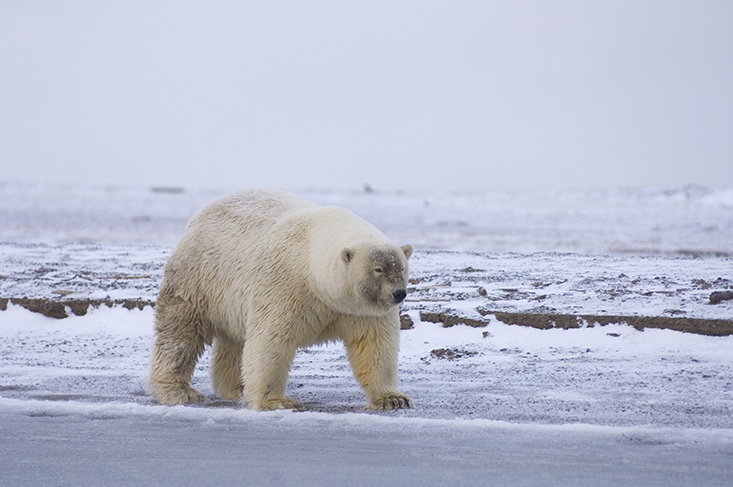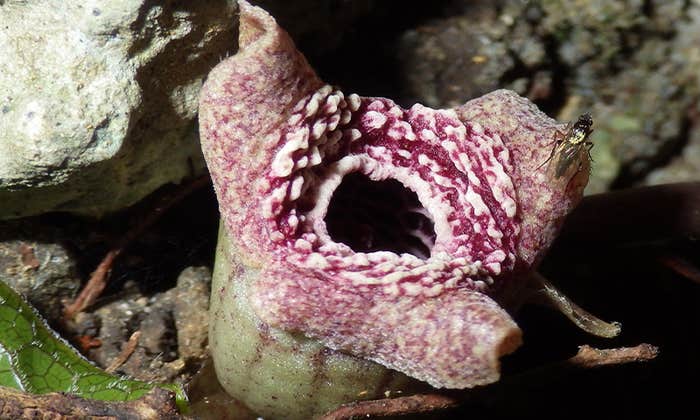The journey began in spring 2010, just as the sea ice surrounding the North Pole began its annual melt. Two bowhead whales, 50-foot-long behemoths that scour the Arctic seas for plankton, each started from their homes on opposite sides of North America—one in the Beaufort Sea north of Alaska, the other in Baffin Bay on the west side of Greenland. As the summer progressed, sea ice shrank (to its third-lowest cover in the last 30 years), and the whales swam toward each other through the now ice-free passage above the continent. Two independent teams of scientists from Canada and the United States watched the whales closely via satellite. “We were all pretty excited,” recalls Kristen Laidre, a biologist at the University of Washington and member of the U.S. team.
In September, in an inlet some 1,800 miles north of Fargo, North Dakota, where the North American landmass dissolves into the Arctic Ocean, the whales met in the middle. They spent two weeks together, and although not much happened before they turned around, the meeting was historic. The fossil record indicates the last time Pacific and Atlantic bowhead whales came into contact was at least 10,000 years ago.
In the last 40 years, the Arctic has warmed by about 3.5 degrees Fahrenheit, more than twice the overall global rise in that same period. Already grizzly bears are tromping into polar bear territory while fish like cod and salmon are leaving their historic haunts to follow warming waters north. One tangible result of the migration, scientists report, is that animals will learn to live with new neighbors. But polar biologists worry that animals could get a little too friendly with each other. With less ice clogging Arctic seas, whales are ranging farther; meanwhile, animals like seals that breed on the ice have fewer places to go. In both cases, the chances of encountering a different species jump. “All of a sudden, hybridization will skyrocket,” says Brendan Kelly, a polar ecologist at the National Science Foundation.
While it’s tempting to imagine a strange new Arctic teeming with “grolar bears” and “narlugas,” hybridization comes at a cost.
The first confirmed cross between a polar bear and a grizzly bear—a white bear with brown patches—was documented in 2006; genetic analysis of a second, found in 2010, revealed that its mother was also a hybrid, suggesting that more instances are happening under scientists’ radar. In 2009, a biologist at the National Marine Mammal Laboratory photographed a probable bowhead/right whale hybrid in the Bering Sea. More hybrids are possible. Kelly and his coauthors have counted 34 opportunities for hybridization across 22 Arctic or near-Arctic species, based on the animals’ genetic compatibility and geographic range. The list includes potential hybrids of ringed and ribbon seals, Atlantic walrus and Pacific walrus, and beluga whales and narwhals.
While it’s tempting to imagine a strange new Arctic teeming with “grolar bears” and “narlugas,” hybridization comes at a cost. Arctic biodiversity will be reduced through gradual consolidation, taking with it a blend of genes that have evolved by natural selection over millennia. “There’s going to be a whole bunch of organisms containing genes that we’re going to lose,” Kelly says. Which genes, exactly, is unclear. A hybrid’s success, like any organism’s, hinges on its fitness to its environment. Because the Arctic is changing rapidly, it’s hard to predict which traits will be most important for, say, a population of grolar bears. Merging features of two well-adapted parent species might help hybrids cope with shifting conditions. But more often than not, Kelly thinks, genetic incompatibilities in hybrids will erase traits crucial to the long-term survival of both parent species. If that happens, he says, “then we can expect a great reduction in those populations, and possibly extinctions.”

Hybrids pop up throughout evolutionary history in cases where some major environmental shift, such as an eroding mountain range, removes a barrier that kept two similar but distinct groups apart. When the glaciers retreated from Northern Europe at the end of the last Ice Age about 13,000 years ago, butterflies fluttering north from Italy met and hybridized, producing the ancestors of the modern-day meadow brown species.
Even humans once dabbled in hybridization, an experience that taught us something about its risks and rewards. When our ancestors spilled out of Africa into Europe, between 37,000 and 85,000 years ago, we encountered communities of Neanderthals, a species from which we had split roughly 550,000 years prior. It’s hard to know what the courtship might have been like (bouquets of sticks? cave-painting classes?), but Homo sapiens found they still had enough in common with Homo neanderthalensis, physically and genetically, to successfully reproduce. The residue of those encounters is still present in the DNA of modern humans, of which about 2 percent is inherited directly from Neanderthals.
The number of those inherited genes may be less significant than what they control, according to studies published in the journals Nature and Science. Both studies confirmed that most of these Neanderthal genes regulate the inner mechanics of hair and skin cells, a sign that natural selection favored the Neanderthals’ adaptations to the cold European climate when those traits were passed along to hybrids. But the Nature study also found that Neanderthal genes are largely missing from the X chromosome of modern human males, a sign that hybrid males were often sterile. That would keep two hybrids from having kids of their own, which explains why rather than merging into a new, third species, humans stayed separate from Neanderthals and eventually outcompeted them to extinction.
Even humans once dabbled in hybridization, an experience that taught us something about its risks and rewards.
Sterile offspring is just one of many ways that hybridizing can go awry. Rather than producing a mash-up super-species with all the best traits of the parents, hybrids are more often dysfunctional, if they’re produced at all, evolutionary biologists believe. The first barrier to hybridization in the wild is fairly obvious: Mom and Dad have to physically, er, fit together (housecats and tigers might have some similar DNA, but good luck getting them to get it on). If mating does happen, sperm from one species might not have the right enzymes for cutting through the outer membrane of the other’s eggs to gain access for fertilization. Once that bridge is crossed and a zygote (the earliest stage of development) is formed, with half its genes from one species and half from the other, the most important test is whether the genes will be compatible enough to successfully carry out their duties.
“Are those genes gonna play well in the same sandbox, or are they going to go after each other?” offers Adam Porter, an evolutionary biologist at the University of Massachusetts, Amherst.
With parents of the same species, a zygote’s genes are in sync, churning out proteins to do the work of metabolism, DNA replication, building vital organs, and other basic physiological functions necessary to create a healthy baby. But if genes in different parent species have evolved in separate ways to conflict or compete with one another, Porter says, “that can screw things up.” The hybrid might never make it past the zygote stage, or it might be born with fatal malfunctions.

As it turns out, hybridization is particularly bad news for male mammals (including our bears, whales, and seals), an observation first made in 1922 by the seminal British biologist J.B.S. Haldane. Because a male’s sole X chromosome comes from only one parent (as opposed to a female, which has one X from each parent), important traits that are controlled by an interaction between X chromosome genes and genes elsewhere are more likely to be incompatible in male hybrids. At the same time, regular competition between males for females drives male reproductive systems to evolve relatively quickly, creating a particularly wide gulf in this respect between otherwise similar species. For these reasons, hybrid males often encounter problems in developing gonads and manufacturing sperm, both of which lead to sterility.
But polar and grizzly bears have passed these tests and proven compatible on a DNA level. So why aren’t grolar (or pizzly, pick your poison) bears taking over the Arctic? Robert Rockwell says differences in the way the bears are hard-wired to behave may keep them romantically disinterested. Rockwell is an ecologist at the American Museum of Natural History in New York City, and was one of the first to document the movement of grizzlies into polar bear territory in northern Manitoba, Canada. This is one of only two places where the species overlap—the other is on the north edge of Alaska. Once the bears are together, well, one thing leads to another.
“There’s going to be some sex happening,” Rockwell says. But sexually active male polar bears are 1,200-pound giants, four times the weight of a female grizzly. That pairing “might be lunch instead of a hybrid.” Moreover, polar bears mate far out on the sea ice, a place it’s rare (though not unheard of) to find a grizzly. Still, during courtship, dominant polar males will drive the scrawny ones off the ice, where they could encounter grizzly females—Rockwell says he’s observed grizzlies hanging out at places where low-ranking polar males come ashore. But at this point, Rockwell says, there just aren’t enough individuals of either species for there to be much real pressure to interbreed. “I think the numbers are such that a hybrid would be pretty rare.”
So will polar and grizzly bears repeat the story of humans and Neanderthals, staying separate until one species drives the other to extinction? Maybe. But climate-driven migrations could tilt the population equation in favor of more meet-ups, and more hybrids. If that happens, the hybrids would meet a different fate, one equally damaging to biodiversity.
When hybrids mate with each other, they form what biologists call a “hybrid swarm” (or a “schmoo,” as Porter puts it). The swarm may lead to sexual compatibility among the parental populations that gave rise to it. Then, through continuous mating, the original species would dissolve into one new one—effectively an extinction by merger. “Basically you’ve swapped out the genome that has been fine-tuned by evolution for thousands of generations,” says Andrew Whiteley, an evolutionary biologist at the University of Massachusetts, Amherst, and a co-author with Kelly.
The biologists explain that there is no set rule for when hybridization becomes impossible. Changes in DNA are highly variable, depending on the species and the natural pressures on it. Different species of European shrew, for example, have been found to interbreed despite having evolved vast differences in the arrangement of their chromosomes, while similar changes in house mice have stopped hybridization cold. Kelly points out that, for reasons that are still being studied, the chromosome count of marine mammals tends to evolve slowly, increasing the odds of a successful hybrid even between species that have been divergent for a long time.
Sexually active male polar bears are 1,200-pound giants, four times the weight of a female grizzly. That pairing “might be lunch instead of a hybrid.”
How exactly this will all play out in the Arctic is an open question because of how quickly the climate is changing. The success (or not) of hybrids is determined at least as much by their environment as by the genes themselves—the same hybrid might be quite well adapted to one environment, and terribly suited to another. Typically, natural selection makes those decisions over thousands of generations, favoring the best-adapted individuals over time until the species fits perfectly in its habitat.
But “we’re speeding up the evolutionary clock,” Kelly says. “If you change an environment rapidly, that’s very few generations, and very little opportunity for an adaptive response.” In other words, hybridization is a roll of the dice, the outcome of which will likely be different for each population of each species.
More than half the polar species identified by Kelly as at-risk for hybridization are listed as endangered or otherwise protected, which means their disappearance would have tangible implications for conservation. Do grolar bears need or merit the same protection as polar bears? The Endangered Species Act says yes, and affords hybrids in the wild the same protection as their endangered parents. But once the hybrids mix into a swarm, with the original species lost altogether, “those changes are very concerning to us,” says Pete Souza, an ecological services manager with the U.S. Fish and Wildlife Service.
On the flip side, Souza says, careful hybridization has been used to bring an imperiled species back from the brink. In the early 1990s, only about 25 Florida panthers remained in the wild. Populations with a gene pool that small are highly susceptible to disease and dysfunction, and have difficulty recovering. So the USFWS imported eight female cougars from Texas, and dropped them off where they were likely to mate with male panthers. They did, and today the panther population has jumped to as high as 160, thanks to a genetic jumpstart courtesy of the cougars.
But Whiteley cautions that we shouldn’t count on a positive outcome. Animals (especially top-tier predators like bears, seals, and whales) don’t live in isolation; each species performs a vital ecological role. This is especially true in the Arctic, where biodiversity is low to begin with, and animals are already under stress from environmental changes. “If we pull at the tapestry enough,” Whiteley says, “things are gonna start to fall apart.”
Tim McDonnell is the associate producer of Climate Desk. His work has appeared in The Guardian, Sierra, and Audubon.






























